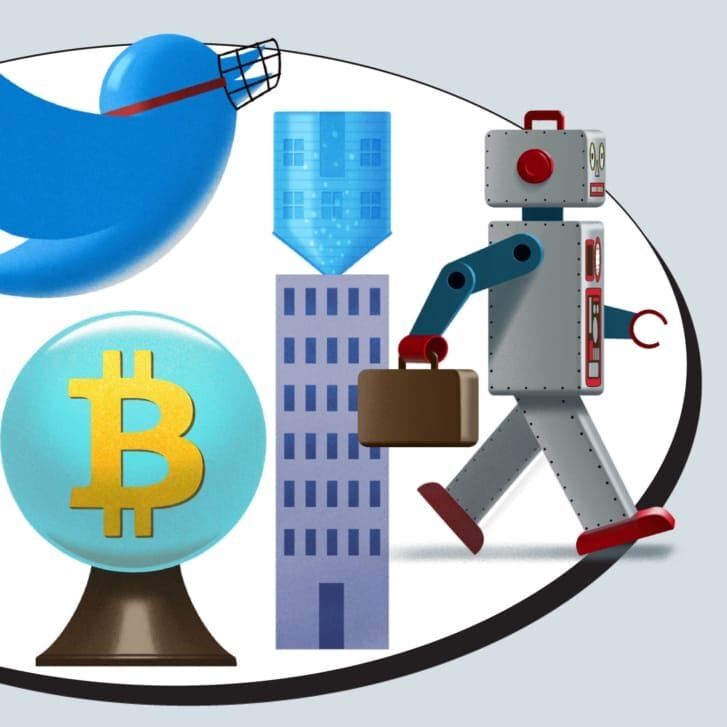Twelve years ago Wharton had no courses on negotiation and few faculty doing research in the area. There was no Center for Human Resources and business ethics was offered to only a few students in elective courses.
All that has changed. The evolution over the past decade of an innovative, team-oriented curriculum in both the graduate and undergraduate programs has inspired a new emphasis on excellent teaching and new directions in scholarly research. Both trends have prompted a fresh wave of faculty-authored business-oriented books in are as ranging from finance to leadership. Two examples include the influential Stocks for the Long Run (McGraw-Hill, 2nd ed., 1998) by finance professor Jeremy Siegel, and last year’s The Leadership Moment: Nine True Stories of Triumph and Disaster and Their Lessons for Us All by management professor Michael Useem (Random House, 1998).
And the publication pace seems to be picking up. In the past four months alone, Wharton faculty members have published books on negotiation, workforce dynamics and ethics. On the following pages we talk to the authors of Bargaining for Advantage: Negotiation Strategies for Reasonable People (Viking/Penguin, 1999) by legal studies department chairperson G. Richard Shell; The New Deal at Work: Managing the Market-Driven Workforce (Harvard Business School Press, 1999) by Peter Cappelli, director of the Center for Human Resources, and Ties That Bind: A Social Contracts Approach to Business Ethics (Harvard Business School Press, 1999) by Wharton’s leading ethics professors, Thomas W. Dunfee and Thomas Donaldson.
What’s Your Best Offer?
Since its introduction in 1988, Wharton’s course on negotiation has been one of the most popular electives in both the MBA and undergraduate curricula. Each semester more than 350 students learn about negotiation in multiple small sections, taught by faculty from four different departments including legal studies, management, operations and information management, and marketing. In addition, the week-long Wharton Executive Negotiation Workshop, sponsored by the Aresty Institute of Executive Education, teaches negotiation to senior managers from all over the world.
 Legal Studies Professor G. Richard Shell was instrumental in helping establish both the MBA and undergraduate courses and was a key player in creating the executive negotiation program. Now Shell has published Wharton’s first book on the subject: Bargaining for Advantage: Negotiation Strategies for Reasonable People.
Legal Studies Professor G. Richard Shell was instrumental in helping establish both the MBA and undergraduate courses and was a key player in creating the executive negotiation program. Now Shell has published Wharton’s first book on the subject: Bargaining for Advantage: Negotiation Strategies for Reasonable People.
“I wanted to write a book that would be reliable and research-based but would also be fun to read,” Shell says. “In our teaching, we found there was no book that filled this need. So I decided to write one myself.”
Shell notes that most popular negotiation books are based solely on the personal “war stories” of the author – typically a sports or entertainment agent. At the other end of the spectrum are academic treatments of bargaining from scholars in psychology, economics or anthropology. “Neither of these approaches works well for an audience of intelligent business and professional readers,” notes Shell. “Our students and executives demand more than war stories, but they don’t have any patience with academic jargon. As someone doing my own research, I already knew the negotiation literature. So I concentrated on reading business and social history to find examples from the lives of extraordinary people that would illustrate the bargaining principles I wanted to discuss.”
Among the illustrations Shell uses are stories from the lives of Wharton alumni, including First Union Corp. CEO Ed Crutchfield, WG’65, and business mogul Donald Trump, W’68, both of whom are well known for their negotiation skills.
 One of the most important lessons Shell has learned from years of research and teaching is that virtually everyone has the tools it takes to be an effective negotiator. The key, he says, is to build on the skills you already possess rather than trying to become a hyper-aggressive, take-no-prisoners type like the character Gordon Gekko in the movie Wall Street. “Aggressive people can be excellent negotiators,” says Shell, “but only if that is their natural style.”
One of the most important lessons Shell has learned from years of research and teaching is that virtually everyone has the tools it takes to be an effective negotiator. The key, he says, is to build on the skills you already possess rather than trying to become a hyper-aggressive, take-no-prisoners type like the character Gordon Gekko in the movie Wall Street. “Aggressive people can be excellent negotiators,” says Shell, “but only if that is their natural style.”
Shell uses the term “information-based bargaining” to describe his approach to negotiation. It focuses on acquiring information in three ways: solid preparation before bargaining begins, careful listening to discern what the other party wants, and attention to the “signals” that the other party sends out through his or her conduct during the process. It’s also important to note that information-based bargaining stresses the use of strategies tailored to the actual situation one is facing, rather than a one-size-fits-all approach.
Shell emphasizes four key personal effectiveness factors that can improve your results, regardless of whether you are a basically cooperative or competitive person. These factors are: a willingness to prepare (something most people know they should do, but don’t); high expectations (because people who expect more usually get it); the patience to listen (because this allows you to learn what the other side wants, which can be used as leverage); and a commitment to personal integrity (which gains you credibility as well as self respect).
So, what kind of person is the best negotiator? There is no simple answer, as Shell has learned over the years. “Competitive people often have the upper hand, at least initially, against other, less aggressive personality types,” notes Shell. “Because competitive people don’t mind interpersonal friction, they have an advantage over someone with no appetite for it.
“But competitive people often lack skills in managing relationships. This gives cooperative people an advantage in any situation where interpersonal trust over the long term is important.
“In general, you’re always better off negotiating against someone who is like yourself,” he adds. “People who have the same personality type trust each other. It’s when different personality types mix that things get dicey.”
And what does Shell recommend to improve your results? Practice. “That is what makes taking a negotiation course such a powerful experience,’ he says. “You get a chance to practice something most people feel anxious about, and do it in a learning environment.”
The New Deal at Work
In the old Father Knows Best TV series, Robert Young’s character had, to all appearances, a terrific job. He never seemed to work long hours, never seemed stressed out, no doubt received regular promotions and raises, and could expect to have a job at the same company for life.
 This kind of employer-employee relationship is, of course, as dead as black-and-white TV sets with rabbit ears. Today employees face a new, more freewheeling kind of workplace that Peter Cappelli, the George W. Taylor Professor of Management, describes in his book, The New Deal at Work: Managing the Market-Driven Workforce.
This kind of employer-employee relationship is, of course, as dead as black-and-white TV sets with rabbit ears. Today employees face a new, more freewheeling kind of workplace that Peter Cappelli, the George W. Taylor Professor of Management, describes in his book, The New Deal at Work: Managing the Market-Driven Workforce.
New management practices have pushed aside such traditional principles as long-term commitment and internal promotion, says Cappelli, replacing them with relationships in which power moves back and forth from employer to employee depending on labor-market conditions.
He describes the transformation as “a cultural change” brought about in part by recession and downsizing. These days, companies “don’t want or need employees to be with them for life, and employees don’t necessarily want to be there for life.”
Another factor in the creation of the new work model is the arrival of more competitive product markets which have increased the pressure to cut costs and reduce time to market, Cappelli notes. Those sectors of the economy that have experienced the greatest need to shorten product life cycles, such as high-technology and financial services, have also experienced the most turmoil in their labor markets.
 Consider New York City, the nation’s financial center, and Silicon Valley, which has a large concentration of computer-related companies. In both locations, it’s easy for employees to change companies without changing industries. “People want to move from company to company but they don’t want to move from region to region,” Cappelli says. “That’s why it’s hard to start a high-tech company if you’re not in Silicon Valley.”
Consider New York City, the nation’s financial center, and Silicon Valley, which has a large concentration of computer-related companies. In both locations, it’s easy for employees to change companies without changing industries. “People want to move from company to company but they don’t want to move from region to region,” Cappelli says. “That’s why it’s hard to start a high-tech company if you’re not in Silicon Valley.”
The New Deal at Work recounts an anecdotal example of how employees appear to be changing employers more frequently but are staying in the same occupations longer than their parents or grandparents. A veteran of Chemical Bank, which is now merged with Chase Manhattan, told Cappelli: “I always thought of myself as a Chemical Bank manager who happened to be in human resources. The new generation of managers think of themselves as human resource managers who happen to be at Chemical.”
The new deal has been slower to establish itself in sectors that have long product life cycles, such as the oil industry. Exxon, like other companies, needs key workers to stick a round until jobs are finished, which in the oil business may take 20 years, Cappelli says.
His book comes on the heels of an earlier study on workplace trends that he completed for the National Policy Association, a Washington-based union-management group. The study reached several conclusions: that the burden of corporate restructuring had fallen squarely on employees’ shoulders and that there was greater uncertainty in employment. But that didn’t seem to tell the whole story.
“The question we were left with at the end of that study was: What does this new model look like?” Cappelli explains. “The argument that we’re now all temps didn’t seem to be exactly right. Another question was: What else was changing? Not just the growing insecurity of employment, but how pay was being determined and how opportunities were being allocated and work was being organized . The third issue was: What do you do about this if you’re a company?”
For example, firms must recognize that compensation needs to reflect the new, more tenuous relationship between employer and employee, Cappelli says. The chance of being promoted can no longer serve as an incentive. Instead, compensation strategies must be clear in delineating exactly what results will be rewarded in what way.
Cappelli sees no quick end to the transformation now taking place and no quick resolution to the challenges employers face in dealing with a brave new world.
“One of the harder issues to face is that companies don’t necessarily control employee attrition,” he says. “Sometimes employees are not pushed out of their companies, they’re pulled. It’s like managing the flow of a river. You’re not going to keep the water from flowing out, but you can manage where and when it goes. It’s the same with employees. That’s a fundamental culture change.”
An Integrative Approach to Business Ethics
What can happen when a company makes ethical missteps? Consider two disasters that befell Royal Dutch Shell in the mid-1990s, both of which are recounted in Ties That Bind: A Social Contracts Approach to Business Ethics by Thomas Donaldson and Thomas Dunfee.
In Nigeria, after environmental activists protested Shell’s plan for a $3.6 billion gas-development project, nine of the activists were hanged by the military government. Critics alleged that the executions would not have occurred had Shell, Nigeria’s largest oil producer, intervened. The company stayed out of the controversy, however, arguing that it was a private company with no role to play in politics. Its defense: large multinationals should avoid pushing their weight around in local affairs.

Dunfee (left) and Donaldson
In another case, Shell announced plans to sink a large oil storage facility called the Brent Spar in the North Sea. Environmental activists protested. Some Greenpeace boats that tried to halt the sinking of the Brent Spar by maneuvering to intercept the Shell rig were nearly sunk by Shell’s ships. Angry Europeans boycotted Shell products. Under pressure, the company decided not to deep-six the rig.
At the time, Shell was widely recognized as a company committed to ethical principles. What went wrong? According to Donaldson and Dunfee, Shell failed to recognize in both cases that the ethical expectations of the people where these events took place conflicted with the standard set of business norms Shell was using to make decisions. It may have been perfectly legal to stay out of Nigerian politics and to sink the Brent Spar. Indeed, Shell thought those actions were arguably ethical, too, under Shell’s own internal analysis. But Shell’s was not the only relevant ethical frame.
“Nigerians were looking at Shell as part of the community,” with certain responsibilities to that community, says Donaldson, Mark O. Winkelman Professor of legal studies and director of the Wharton Ethics Program. In the oil-rig case, he adds, Shell learned that “you just can’t act with a lot of hubris, following what you think is right.”
Across the globe, many companies face problems like the ones Shell confronted. As they wrestle with ethical decisions, companies may rightly ask what standards they should use to make those decisions. Should they adhere to a fixed set of universal ethical principles that can be applied everywhere?
Or should they readily bend principles of right and wrong to fit the peculiar circumstances encountered in each case?
 Taken alone, Dunfee and Donaldson say, neither approach is enough. Instead, the best framework is a combination of the two approaches, which the researchers have labeled Integrative Social Contracts Theory (ISCT).
Taken alone, Dunfee and Donaldson say, neither approach is enough. Instead, the best framework is a combination of the two approaches, which the researchers have labeled Integrative Social Contracts Theory (ISCT).
To understand the Dunfee/Donaldson approach to business ethics, you must first get an idea of what they mean by the term “social contract.” A social contract is an agreement, usually unwritten, specifying the mutual obligations of people who form various types of communities.
Social contracts can take two forms – macro and micro, the authors say. Macro social contracts are intended to set universal, objective standards for behavior among people and organizations. These contracts give people the implied duties they all must adhere to as human beings living in social relationships. An example would be a basic duty to condemn the torture of prisoners.
Micro social contracts involve specific ethical rights and obligations that exist in a variety of smaller, more local circumstances. The norms in micro social contracts are flexible and can differ from community to community. The norms of the macro social contract do not change.
For example, the macro social contract may require people to tell the truth, to respect the environment and to be fair to others. Nonetheless, there may be differences from community to community as to how these moral precepts are actually put into practice in everyday life.
Suppose XYZ Corp. has a policy forbidding its managers to accept bribes. One of its executives, while on a business trip, is offered a fairly expensive gift by a Japanese supplier. What should she do? One option is to adhere to XYZ’s policy to the letter and refuse the gift. But that may insult the gift-giver, since a deeply rooted micro social contract among Japanese encourages gift-giving, including gifts that are costly.
One solution to this dilemma, Donaldson says, would be for XYZ to do what other companies have done and adjust its gift-giving policy for Japanese circumstances. Using the ISCT approach, XYZ would recognize that not all gifts should be interpreted as bribes. XYZ could spell out for managers when it is proper and improper to accept gifts in the special circumstances posed by the Japanese business culture.
There are times, however, when the mandatory rules of the macro social contract override any micro social contracts that may exist. For instance, even if apartheid policies mandate that companies racially segregate their washrooms, as once was the case in South Africa, it would still be wrong for a multinational firm to comply with the policy. “On some things,” Donaldson says, “you don’t give an inch.”
The authors say their approach represents a radical departure from those of other business-ethics researchers who traditionally have emphasized universal norms out of fear that any weight given to micro social contracts could lead to relativism, with companies making up codes of right and wrong as they go along.
But Donaldson and Dunfee stress that ISCT is not relativistic. “Some philosophers bend over backward s not to pay attention to [micro] professional practices, norms and experiences [in real life],” says Dunfee, Joseph Kolodny Professor of Social Responsibility in Business and director of the Zicklin Center for Business Ethics Research. “They approach the subject in the abstract, without much context. We have worked mightily to give [micro social contracts] the appropriate relevance” without slipping into ethical relativism.
ISCT, the authors say, avoids the traditional weakness of macro contracts (their vagueness) as well as the weakness of micro contracts (that they can lead to morally repugnant behavior). ISCT avoids relativism by insisting that any micro contracts be in accordance with moral limits established by a macro contract.
In a personal way, ISCT represents a merging of the authors’ own ethical predilections. Donaldson, a philosopher who joined Wharton in 1996 after teaching at Georgetown University, is inclined to take a macro view of business ethics. He has spent his career focusing primarily on universal principles posited by seminal thinkers like Plato and Kant. Dunfee, an attorney who has taught ethics at Wharton since 1974, is more apt to take a micro view. He has largely focused on difficult ethical problems that crop up in everyday business dealings.
Says Dunfee: “Ethics is more than just avoiding lawsuits and the public relations problems that can happen if you run afoul of public morality. There are also positive opportunities. People may choose to do business with you if you are aligned with public morality as opposed to buying from a company that is less aligned. And there may be greater public forgiveness of your firm if [an ethical] problem does occur.”


























